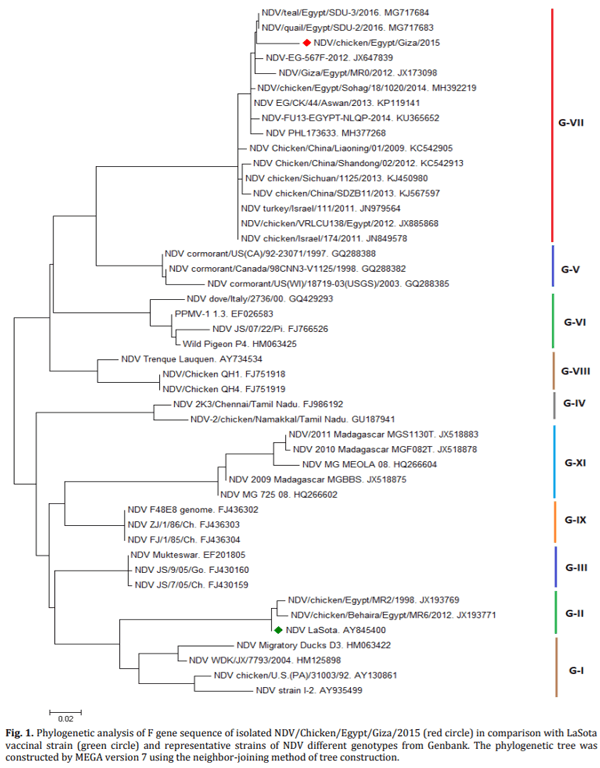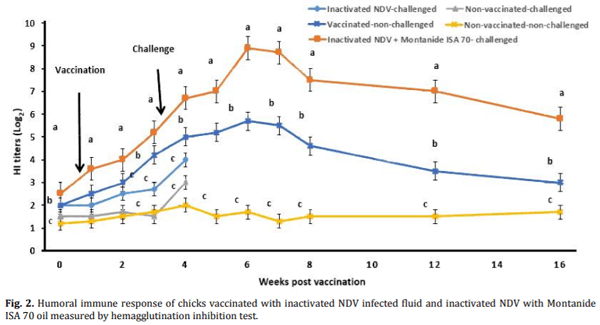Efficacy of inactivated velogenic Newcastle disease virus genotype VII vaccine in broiler chickens
Newcastle disease (ND) causes severe economic losses in poultry production. Despite the intensive vaccination regimes of NDV in Egypt, many outbreaks are being reported. The present study focused on the preparation and evaluation of inactivated velogenic Newcastle disease virus vaccine (genotype VII) isolated from Egyptian broiler chicken during 2015-2016. Fifty-five tissue samples including trachea, lung, liver, proventriculus, intestine, and kidney collected from commercial broiler chickens were used for virus isolation in specific pathogen-free embryonated chicken eggs (ECE) and identified using RT-PCR and sequencing. The isolates were classified by sequencing as velogenic NDV genotype VIId containing F0 protein cleavage site motifs (112RRQKRF117). A selected isolate was served as a master seed for the preparation of inactivated NDV vaccine with or without Montanide ISA70 adjuvant and evaluated in SPF chicks. Nine NDV isolates were isolated on ECE and the highest infectivity titer of the virus was 7.50 log10 EID50 mL-1 by the 5th passage. Vaccinated chicks with NDV-Montanide ISA70 adjuvanted vaccine exhibited antibody titer of 5.20 log2 at the 3rd-week-post-vaccination (WPV) with the highest titer (8.90 log2 mL-1) at the 6th-WPV. Protective antibodies values were persisted to 12th WPV followed by a gradual decrease to the end of the experiment (16th weeks). Vaccination of chicks with inactivated NDV isolate without adjuvant failed to induce protective HI antibodies all over the experiment. Chickens vaccinated with the ISA70 adjuvant vaccine were passed homologous challenge tests with 100% protective efficiency, while the unadjuvanted vaccine could not provide any protective efficiency. In conclusion, the preparation of inactivated oil adjuvant vaccine from NDV field circulating strains was efficient in controlling the disease in Egypt.
Keywords: Egypt Genotypes VIId, Inactivated vaccine, Newcastle disease virus.



- Nordin M, Lorenz T, Campello M. Biomechanics of tendons and ligaments. IN: Nordin M. Frankel VH (Eds). Basic biomechanics of the musculoskeletal system London, UK: Lippincott Williams & Wilkins 2001; 102-125.
- Lamb RA, Collins PL, Kolakofsky D, et al. Family Paramyxoviridae. In: Fauquet CM, Mayo J, Maniloff J, et al (Eds). Virus taxonomy. London, UK: Elsevier/Academic Press 2005; 655- 668.
- Römer-Oberdörfer A, Werner O, Veits J, et al. Contribution of the length of the HN protein and the sequence of the F protein cleavage site to Newcastle disease virus pathogenicity. J Gen Virol 2003; 84) 11): 3121-3129.
- Alders RG and Spradbrow PB. Controlling Newcastle Disease in Village Chickens: a field manual. Canberra, Australian Centre for International Agricultural Research 2001; Monograph 82.112.
- Doubney R and Mansy W. The occurrence of Newcastle disease in Egypt. J Comp Pathol 1948; 58(1): 189-200.
- Diel DG, da Silva LH, Liu H, et al. Genetic diversity of avian paramyxovirus type 1: proposal for a unified nomenclature and classification system of Newcastle disease virus genotypes. Infect Genet Evol 2012; 12(8): 1770-1779.
- Huang Y, Wan HQ, Liu HQ, et al. Genomic sequence of an isolate of Newcastle disease virus isolated from an outbreak in geese: a novel six nucleotide insertion in the non-coding region of the nucleoprotein gene. Brief report. Arch Virol 2004; 149(7): 1445-1457.
- Tsai HJ, Chang KH, Tseng CH, et al. Antigenic and genotypical characterization of Newcastle disease viruses isolated in Taiwan between 1969 and 1996. Vet Microbiol 2004; 104(1-2): 19-30.
- Aldous EW, Mynn JK, Banks J, et al. A molecular epidemiological study of avian paramyxovirus type 1 (Newcastle disease virus) isolates by phylogenetic analysis of a partial nucleotide sequence of the fusion protein gene. Avian Pathol 2003; 32(3): 239-256.
- Lin MY, Liu HJ, Ke GM. Genetic and antigenic analysis of Newcastle disease viruses from recent outbreaks in Taiwan. Avian Pathol 2003; 32(4): 345-350.
- Bogoyavlenskiy A, Berezin V, Prilipov A, et al. Newcastle disease outbreaks in Kazakhstan and Kyrgyzstan during 1998, 2000, 2001, 2003, 2004, and 2005 were caused by viruses of the genotypes VIIb and VIId. Virus Genes 2009; 39(1): 94-101.
- Snoeck CJ, Ducatez MF, Owoade AA, et al. Newcastle disease virus in West Africa: new virulent strains identified in non-commercial farms. Arch Virol 2009; 154(1): 47-54.
- Radwan MM, Darwish SF, El-Sabagh IM, et al. Isolation and molecular characterization of Newcastle disease virus genotype ?? and VΠd in Egypt between 2011 and 2012. Virus Genes 2013; 47(2): 311-316.
- Pchelkina IP, Manin TB, Kolosov SN, et al. Characteristics of pigeon paramyxovirus serotype-1 isolates (PPMV-1) from the Russian Federation from 2001 to 2009. Avian Dis 2013; 57(1): 2-7.
- Aly SE. phylogenetic analysis of lentogenic strains of Newcastle disease virus. Master thesis Cairo University 2012; 83-84.
- Hu Z, Hu S, Meng C, et al. Generation of a genotype VII Newcastle disease virus vaccine candidate with high yield in embryonated chicken eggs. Avian Dis 2011; 55(3): 391-397.
- OIE. Manual of diagnostic tests and vaccines for terrestrial animals. Newcastle Disease. 2012; Chapter 2. 3. 4.
- Reed LJ and Muench H. A simple method of estimating fifty percent endpoints. The Am J Hyg 1938; 27(3): 493-497.
- Mase M, Imai K, Sanada Y, et al. Phylogenetic analysis of Newcastle disease virus genotypes isolated in Japan. J Clin Microbiol 2002; 40(10): 3826-3830
- Razmaraii N, Toroghi R, Babaei H, et al. Immuno-genicity of commercial, formaldehyde and binary ethyl-enimine inactivated Newcastle disease virus vaccines in specific pathogen free chickens. Arch Razi Inst 2012; 67(1): 21-25.
- OIE. Manual of diagnostic tests and vaccines for terrestrial animals. Newcastle Disease. 2014; Chapter 2.3.14.
- Oyebanji VO, Emikpe OB, Oladele OA, et al. Clinico-pathological evaluation of Newcastle disease virus vaccination using gums from Cedrela odorata and Khaya senegalensis as delivery agents in challenged chickens. Int J Vet Sci Med 2017; 5(2): 135-142.
- Sarcheshmei M, Dadras H, Mosleh N, et al. Comparative evaluation of protective efficacy of different vaccination programs against a virulent field strain of the Newcastle disease virus in broilers. Brazilian Journal of Poultry Science 2016; 18(3): 363-370.
- Nabila O, Sultan S, Ahmed AI, et al. Isolation and patho-typing of Newcastle disease viruses from field outbreaks among chickens in the southern part of Egypt 2011-2012. Global Veterinaria 2014; 12(2): 237- 243
- Orabi A, Hussein A, Saleh AA, et al. Evolutionary insights into the fusion protein of Newcastle disease virus isolated from vaccinated chickens in 2016 in Egypt. Arch Virol 2017; 162(10): 3069-3079.
- Sedeik ME, Elbestawy AR, El-Shall NA, et al. Comparative efficacy of commercial inactivated Newcastle disease virus vaccines against Newcastle disease virus genotype VII in broiler chickens. Poult Sci 2019; 98(5): 2000-2007
- Shahar E, Haddas R, Goldenberg D, et al. Newcastle disease virus: Is an updated attenuated vaccine needed? Avian Pathol 2018; 47(5): 467-478.
- Fringe R, Bosman AM, Ebersohn K, et al. Molecular characterisation of Newcastle disease virus isolates from different geographical regions in Mozambique in 2005. Onderstepoort J Vet Res 2012; 79(1): E1-7.
- Grimes SE. A basic laboratory manual for the small-scale production and testing of I-2 Newcastle disease vaccine. In FAO Regional Office for Asia and the Pacific publication. Bangkok, Thailand. 2002; 139.
- El-Bagoury GF, El-Nahas EM, Abd-El-Monem MM, et al. Detection and pathotyping of a recent Newcastle disease virus outbreak in Egypt. Benha Vet Med J 2015; 29(2): 297-302.
- Mohamed MHA, Kumar S, Paldurai A, et al. Sequence analysis of fusion protein gene of Newcastle disease virus isolated from outbreaks in Egypt during 2006. Virol J 2011; 8: 237.
- Hassan KE, Shany SA, Ali A, et al. Prevalence of avian respiratory viruses in broiler flocks in Egypt. Poult Sci 2016; 95(6): 1271-1280.
- Abd El Aziz M, Abd El-Hamid H, Ellkany H, et al. Biological and molecular characterization of Newcastle disease virus circulating in chicken flocks, Egypt, during 2014-2015. Zag Vet J 2016; 44(1):9-20.
- Mondal SK, Neelima M, Seetha S, et al. Validation of the inactivant binary ethylenimine for inactivating rabies virus for veterinary rabies vaccine production. Biologicals 2005; 33(3): 185-189.
- Kamaraj G, Lakshmi Narasu M, Srinivasan VA. Validation of betapropiolactone (BPL) as an inactivant for infectious bovine rhinotracheitis (IBR) virus. Res Vet Sci 2008; 85(3):589-594.
- Burrage T, Kramer E, Brown F. Structural differences between foot-and-mouth disease and papillomyelitis viruses influence their inactivation by aziridines. Vaccine 2000; 18(22): 2454-2461.
- Mudasser H, Iftikhar H, Hamid I, et al. Immunogenicity of formaldehyde and binary ethylenimine inactivated infectious bursal disease virus in broiler chicks. J Zhejiang Univ Sci B 2006; 7(8): 660-664.
- King DJ. Evaluation of different methods of inactivation of Newcastle disease virus and avian influenza virus in egg fluids and serum. Avian Dis 1991; 35(3): 505-514.
- Mohammadi AA, Hooshamand-Rad P, Ahourai P, et al. Development and manufacture of an inactive oil emulsion Newcastle disease vaccine in Iran. Arch Inst Razi 1996; 1(46/47): 91-99.
- Liu CG, Liu M, Liu F, et al. Evaluation of several adjuvants in avian influenza vaccine to chickens and ducks. Virol J 2011; 8: 321. doi: 10.1186/1743-422X-8-321.
- Wang JY, Liu WH, Ren JJ et al. Characterization of emerging Newcastle disease virus isolates in China. Virol J 2015; 12: 119.
- Miller PJ, Afonso CL, El Attrache J, et al. Effects of Newcastle disease virus vaccine antibodies on the shedding and transmission of challenge viruses. Dev Comp Immunol 2013; 41(4): 505-513.
- Miller PJ, King DJ, Afonso CL, et al. Antigenic differences among Newcastle disease virus strains of different genotypes used in vaccine formulation affect viral shedding after a virulent challenge. Vaccine 2007; 25(41): 7238-7246.
- Xiao S, Nayak B, Samuel A, et al. Generation by reverse genetics of an effective, stable, live-attenuated Newcastle disease virus vaccine based on a currently circulating highly virulent Indonesian strain. PLoS One 2012; 7(12): e52751.
- Mandour MF, Abd-Eldaim MM, Abdelwahab SAM, et al. Rapid detection of foot and mouth disease virus from tongue epithelium of cattle and buffaloes in Suez Canal area, Egypt from 2009 to 2011. Int J Virol 2014; 10(1): 55-62.
- Diel DG, Susta L, Cardenas Garcia S, et al. Complete genome and clinicopathological characterization of a virulent Newcastle disease virus isolate from South America. J Clin Microbiol 2012; 50(2): 378-387.
Dear Dr. Mustafa
Greeting
for sure, comparison between commercial killed vaccine which contains genotype 2 and killed vaccine which contains strain homologous strain as field strain to evaluate the efficacy of different vaccine against ND genotype 7; is a good idea.
We already did it; please check the following articles on engormix
https://en.engormix.com/poultry-industry/articles/evaluation-some-vaccination-programs-t45290.htm
or original publication: https://thescipub.com/abstract/ajavsp.2019.197.206
Please read it and give us feedback
Regards
Wael

Trial better to compare between commercial killed vaccine which contains genotype 2 and killed vaccine which contains strain homologous strain as field strain to evaluate the efficacy of different vaccine against ND genotype 7.











.jpg&w=3840&q=75)